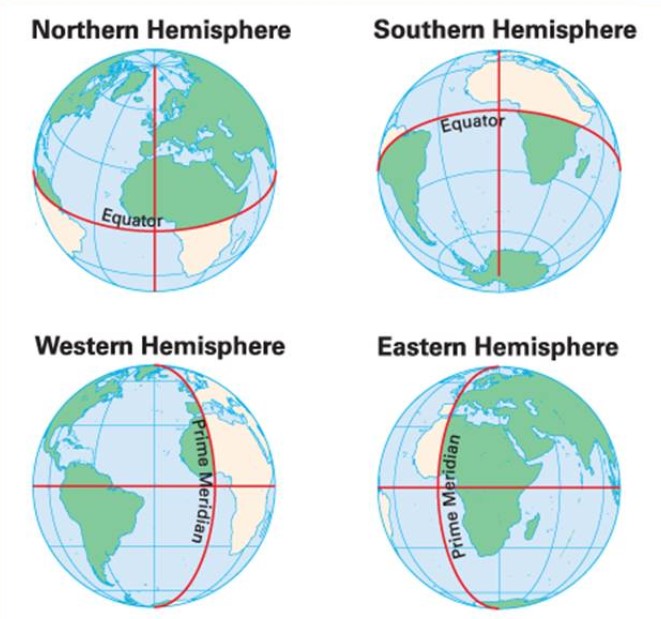Africa: The Continent of All Hemispheres
Of Earth’s seven continents, only one remarkable landmass stretches into all four hemispheres – Africa. Thanks to twists of geography and scale, Africa uniquely straddles the dividing lines of latitude and longitude. These lines delineate eastern from western lands and northern countries from southern ones. Consequently, significant portions of its sprawling territory extend into each hemispheric quadrant.
This special positioning speaks both to the sheer size of the world’s second largest continent. It also shows its centrality regarding the history and connectivity tying together global spheres over millennia.

What Defines the Four Hemispheres?
First, what specifically delineates Earth’s four hemispheres? Two important imaginary lines divide global geography into convenient halves:
The Equator – This latitude line marks 0 degrees, halfway between the North and South Poles. It separates the Western and Eastern Hemispheres. Lands north of the equator reside in Earth’s Northern Hemisphere. Terrain south of the line falls in the Southern Hemisphere.
Prime Meridian – Stretching pole-to-pole at 0 degrees longitude, the Prime Meridian divides Eastern lands from the Western Hemisphere. By convention, regions east of this line comprise the Eastern Hemisphere, with western geography labeled accordingly as the Western Hemisphere.
Where Hemispheres Intersect – Null Island
Visualizing where these two lines virtually intersect provides a unique spot occupying all four hemispheres simultaneously. By extending out the equator and Prime Meridian to their crossover point, we would arrive in the Atlantic Ocean at a place dubbed “Null Island.” This “Null Island” sits precisely at 0 degrees latitude and 0 degrees longitude. This aptly-named speck has the prestigious distinction of existing concurrently in the Northern, Southern, Eastern and Western Hemispheres.
How Africa Uniquely Occupies All Hemispheres
Zooming back to survey a world map, we can clearly distinguish Africa as the sole continent reaching into every hemispheric quadrant. This is thanks to the luck of latitude/longitude and its sheer landmass sprawl.
Along Earth’s waistline sits the equator, dividing our globe into Northern and Southern realms. This all-important line happens to cut through no fewer than 7 different African countries. It encompasses vast lands and populations – including the entire Democratic Republic of Congo sitting squarely astride of it.

Meanwhile, 5 additional African nations curve further northward into the Western geographical hemisphere This is defined from the Prime Meridian, which has long separated Eastern lands from Western ones.
Most distinctively, the continent not only touches all 4 hemispheres but contains substantial masses and countries within them – over 20 million square kilometers collectively. No other landmass achieves such broad geo-hemispheric inclusion. South America, Antarctica and Australia all sit mainly to one side of the key dividing lines of latitude and longitude. Even the sprawling Eurasian mega-continent generally hugs the eastern hemispheric region apart from Russia’s extreme northern frontier.
Shared History and Trade Winds Tie Africa to All Hemispheres
Of course, African cultures actively crossed hemispheric thresholds for centuries through exploration, trade and conquest long before GPS or even early exploratory maps outlined boundaries.
North-South trade routes tracked resources across the Mediterranean’s dividing line of latitude. Similarly, crucial East-West trade winds propelled swifter voyages catalyzing exchange. This boosted emperordoms controlling flow across hemispheres like southern Africa’s Great Zimbabwe and the venerable northern dynasties tracing through Egyptian lineages back millennia.
Later thriving coastal trade permeated busy Indian and Atlantic Ocean ports closely tied to intuitive sailing skills using wind patterns and stars developed long before Western mariners tapped them.
Most profoundly, humanity’s own genesis scientifically points to eastern hemisphere genesis points in Africa for the gradual dawn of homo sapiens arising on the continent before expanding in waves over 75,000 years filling all global hemispheres since.
So in multiple respects, Africa’s bridging of all four hemispheres seems fitting, as both the cradle of humankind and enduring hub whose myriad realms long graced all four quarters thanks in part to intelligent adaptation etched into the very continents’ sweeping mega-geography. One cannot help wonder whether such broad connections predisposed expansive thinking forging shared human futures as well over the horizon of time.



